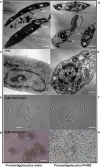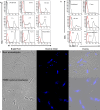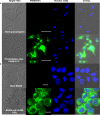Pathogen- and Host-Directed Antileishmanial Effects Mediated by Polyhexanide (PHMB)
- PMID: 26431058
- PMCID: PMC4592236
- DOI: 10.1371/journal.pntd.0004041
Pathogen- and Host-Directed Antileishmanial Effects Mediated by Polyhexanide (PHMB)
Abstract
Background: Cutaneous leishmaniasis (CL) is a neglected tropical disease caused by protozoan parasites of the genus Leishmania. CL causes enormous suffering in many countries worldwide. There is no licensed vaccine against CL, and the chemotherapy options show limited efficacy and high toxicity. Localization of the parasites inside host cells is a barrier to most standard chemo- and immune-based interventions. Hence, novel drugs, which are safe, effective and readily accessible to third-world countries and/or drug delivery technologies for effective CL treatments are desperately needed.
Methodology/principal findings: Here we evaluated the antileishmanial properties and delivery potential of polyhexamethylene biguanide (PHMB; polyhexanide), a widely used antimicrobial and wound antiseptic, in the Leishmania model. PHMB showed an inherent antileishmanial activity at submicromolar concentrations. Our data revealed that PHMB kills Leishmania major (L. major) via a dual mechanism involving disruption of membrane integrity and selective chromosome condensation and damage. PHMB's DNA binding and host cell entry properties were further exploited to improve the delivery and immunomodulatory activities of unmethylated cytosine-phosphate-guanine oligodeoxynucleotides (CpG ODN). PHMB spontaneously bound CpG ODN, forming stable nanopolyplexes that enhanced uptake of CpG ODN, potentiated antimicrobial killing and reduced host cell toxicity of PHMB.
Conclusions: Given its low cost and long history of safe topical use, PHMB holds promise as a drug for CL therapy and delivery vehicle for nucleic acid immunomodulators.
Conflict of interest statement
RF, LG and HM hold or have applied for patents on this topic. All other authors have declared that no competing interests exist. This does not alter our adherence to PLOS policies on sharing data and materials.
Figures








Similar articles
-
Polyhexamethylene Biguanide:Polyurethane Blend Nanofibrous Membranes for Wound Infection Control.Polymers (Basel). 2019 May 22;11(5):915. doi: 10.3390/polym11050915. Polymers (Basel). 2019. PMID: 31121845 Free PMC article.
-
Fungal cell barriers and organelles are disrupted by polyhexamethylene biguanide (PHMB).Sci Rep. 2023 Feb 16;13(1):2790. doi: 10.1038/s41598-023-29756-w. Sci Rep. 2023. PMID: 36797386 Free PMC article.
-
Bactericidal effects of polyhexamethylene biguanide against intracellular Staphylococcus aureus EMRSA-15 and USA 300.J Antimicrob Chemother. 2016 May;71(5):1252-9. doi: 10.1093/jac/dkv474. Epub 2016 Jan 28. J Antimicrob Chemother. 2016. PMID: 26825118
-
Polyhexamethylene biguanide and its antimicrobial role in wound healing: a narrative review.J Wound Care. 2023 Jan 2;32(1):5-20. doi: 10.12968/jowc.2023.32.1.5. J Wound Care. 2023. PMID: 36630111 Review.
-
Polyhexanide - safety and efficacy as an antiseptic.Tidsskr Nor Laegeforen. 2016 May 3;136(8):707-11. doi: 10.4045/tidsskr.14.1041. eCollection 2016 May. Tidsskr Nor Laegeforen. 2016. PMID: 27143460 Review. English, Norwegian.
Cited by
-
The Effects of Polyhexamethylene Biguanide (PHMB) and TLR Agonists Alone or as Polyplex Nanoparticles against Leishmania infantum Promastigotes and Amastigotes.Vet Sci. 2020 Nov 13;7(4):179. doi: 10.3390/vetsci7040179. Vet Sci. 2020. PMID: 33202979 Free PMC article.
-
Host-directed therapies for infectious diseases: current status, recent progress, and future prospects.Lancet Infect Dis. 2016 Apr;16(4):e47-63. doi: 10.1016/S1473-3099(16)00078-5. Lancet Infect Dis. 2016. PMID: 27036359 Free PMC article. Review.
-
Polyhexamethylene Biguanide and Nadifloxacin Self-Assembled Nanoparticles: Antimicrobial Effects against Intracellular Methicillin-Resistant Staphylococcus aureus.Polymers (Basel). 2018 May 12;10(5):521. doi: 10.3390/polym10050521. Polymers (Basel). 2018. PMID: 30966555 Free PMC article.
-
Effect of Local Administration of Meglumine Antimoniate and Polyhexamethylene Biguanide Alone or in Combination with a Toll-like Receptor 4 Agonist for the Treatment of Papular Dermatitis due to Leishmania infantum in Dogs.Pathogens. 2023 Jun 10;12(6):821. doi: 10.3390/pathogens12060821. Pathogens. 2023. PMID: 37375511 Free PMC article.
-
Antimicrobial Polymers: The Potential Replacement of Existing Antibiotics?Int J Mol Sci. 2019 Jun 4;20(11):2747. doi: 10.3390/ijms20112747. Int J Mol Sci. 2019. PMID: 31167476 Free PMC article. Review.
References
-
- Choi CM, Lerner EA. Leishmaniasis as an emerging infection. J Investig Dermatol Symp Proc. 2001;6: 175–82. - PubMed
-
- World Health Organization. Technical Report Series on control of the leishmaniases. Geneva, 22–26 March. 2010;949: 1–187. - PubMed
-
- Lockwood D. Soldiers battle “Baghdad boil.” Nat Med. 2004;10: 110–110. - PubMed
Publication types
MeSH terms
Substances
LinkOut - more resources
Full Text Sources
Other Literature Sources

